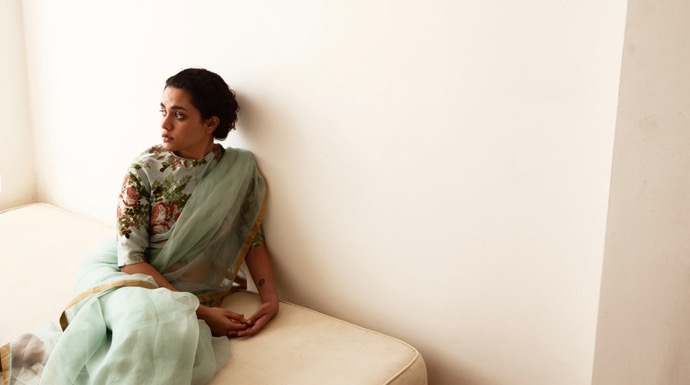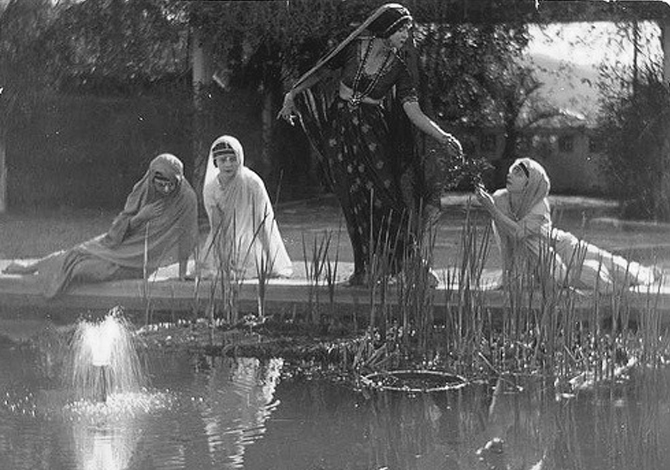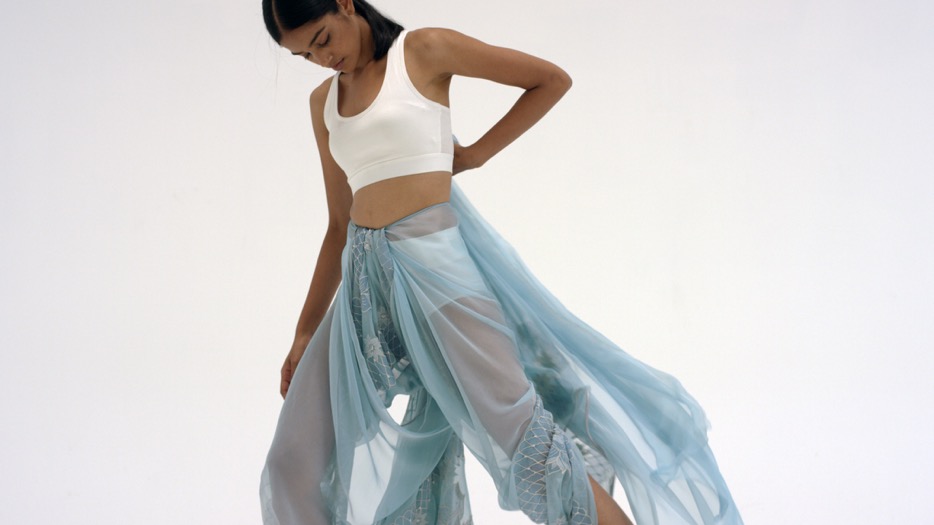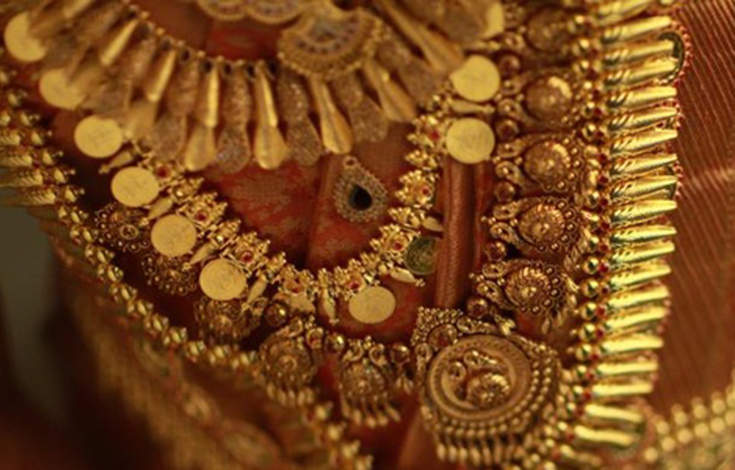As we publicly embark on our cultural documentation of the sari through short film, I would like to share why Border&Fall decided to participate in an ongoing conversation about its relevance with a project of this scope and magnitude.
The terms ‘relevance’ and ‘cultural documentation’ are charged and bear weight (as does ‘sari’ … or is it ‘saree’?). However, in order to have a conversation about the future, a documentation of the past is equally important, as knowing where we come informs where we are headed. We are increasingly seeing the sari worn for occasion wear and moreover in a single draping style. The Nivi drape is the most commonly associated drape of sari while in fact, there are over 100 that exist.
As with all the sari drapes in the past, we believe the sari must continue to adapt to reflect our current lives – in which a floor length sari with a blouse, petticoat and 15 safety pins may seem cumbersome to everyday living. The irony remains that most of the drapes do not have a petticoat, are often worn without a blouse and always without safety pins.
In fact, the sari drapes we have (but don’t wear) happen to be very relevant to today’s context – whether for the sake of style, sustainability or India’s rapidly changing culture.
Perhaps part of the reason is because there is no easily accessible place where one can understand how to drape them with ease. As such, our intention is to produce a series of how-to drape films that document the sari drapes, with our eyes looking towards the future. These will be available free of cost across multiple digital platforms. In addition, we will produce three independent short films that speak to the sari’s past, present and future. This is a complement to the how-to films, engaging in the same dialogue with three distinct filmmakers.
Many have worked for decades to champion the sari; Chantal Boulanger wrote An Illustrated Guide to the Indian Art of Draping in 1997 and Rta Kapur Chishti Saris: Tradition and Beyond in 2010. Both of these books are a compilation of over 100 sari drapes and a testament to decades of laborious work by their authors. Our first collaborator for this project was Rta, considered India’s leading authority on the sari and its drape. Fortunate for us that she joined this project as our Sari Advisor, lending her expertise to ensure correct representations of the drapes and continuing to sharing her wealth of knowledge to new audiences and across new mediums.
This project is not only documentation, it is an opportunity to further develop our aesthetic – allowing for a visual representation of the sari that does not come across as either traditional or ‘contemporary’ (or worse – appropriated). Those of us working with India’s design communities are acutely aware of the burgeoning aesthetics that still lack a representative set of visuals and language to accurately express the changes taking shape, many of them over the last few decades. As such, it was important to us that this team was strong and balanced with a diverse set of talents – and I recalled a short Chloe film I saw in 2011 directed by Bon Duke. It was at the beginnings of ‘fashion film’ as a genre and had struck me as fresh and on point. We’re glad that Bon could envisage the impact our project will make and will be coming to India to film our how-to’s along with one independent film early next year.
An image from Pooja Kaul’s film, Rasikan Re had been in my inspiration folder for years – and our longstanding collaborator, designer Rashmi Varma, reminded us of her at the opportune time. Both are on board bringing their sensitive and intimate understanding of India, women, textile and film. Creative Director Deep Kailey adds her inquisitive eye honed from years of image making.
Through her research, Julia Smith, who is project managing this initiative, came across filmmaker Q’s sari footage. Over the last decade he’s been working on a personal documentation of the sari that remains unfinished. Our collaboration will see some of his footage being used to make a film for us (and hopefully the completion of his own).
Our Advisory Board consists of strong critical voices, each sharing a common interest in India’s developing design language (and thankfully, in Border&Fall). It is comprised of Sunitha Kumar Emmart – Founder/Director of GallerySKE and Sanjay Garg – Textile Designer/Founder of Raw Mango. Of course, our wonderful team at Border&Fall remains at the heart of making this happen – we are fortunate for all involved.
After months of building the architecture for this project – signing the teams, and figuring out logistics and meeting fundraisers – we are announcing the project with a public ask for funding. It feels strange to be in a place to ask for money but also strangely correct. The sari and its documentation belongs to no one, yet millions.
We need 1Crore (USD 150,000) to make this happen. I acknowledge it is a large and expensive project, despite accounting for a significant waiver of fees for all involved. We are happy to share the hard costs for those who inquire. We are thankful for anything you can contribute – whether it be funding, in-kind donations, helping to share this project or simply words of encouragement.
Even in the early stages of this project, it has become clear that the sari is held dearly in the hearts and minds of many. The emotions attached to it are thousand-fold, as are the ways to document it. This is not the definitive anthology of drape – as it remains an evolving garment, open to adaptation. Rather, it is an anthology of drape – one that wishes to contribute to a much needed perception shift of the garment, where its relevance ceases to be questioned at all.





Beautiful Article malika.. Good luck with the sari project!!
You make a clear reasons why the sari?
great write up!
best of luck as you see it come to life…..
RK
This is a wonderful initiative! I will help spread the word.
This is a most original and wonderful idea, Mallika!
I am a huge fan of the sari myself, and love the art of individual and distinctive weaves from our various states on which a lot has been researched and written. But the draping varieties is a first, thanks to you.
I will spread the word and contribute what I can. (Need to look at your presentation in more detail).
Thank you for doing this and Best of Luck! So excited for and with you!
Hi Mallika, this strikes such a deep chord…for me, the sari evokes my mom and all the amazing women in my family, who draped it everyday with ease and elegance (and yes, nary a safety pin in sight).
Living outside india means that the sari has come to represent not just the maternal embrace but my culture, my traditions, my homeland and the aching, ever-present pain of separation. After relegating my own sari collection to the occasional festive outing, I now seek every opportunity to dip into it with joy. I have and love the eye-opening Rta kappor chisti book you mention in the piece and the section on different drapes is my absolute favorite. Anyone who thinks you cannot straddle motorcycles and climb trees in a saree needs to see the versatility of these drapes and that’s where this project will really strike a chord. I am delighted to be a backer and can’t wait to see the magic the team creates.
What a wonderful project! We feels so sad and helpless when we’re told that this is the last person/family that has the skill to make this type of a sari. Our culture is woven into the sari! Unfortunately both casual and formal wear is now seen as chic only if it is western.
Glad that this project is going to showcase the myriad drapes that have been ignored of late. Along with the sari blogs we should have a blog of different drapes-making them more common and acceptable not relegated to the realm of the catwalk!